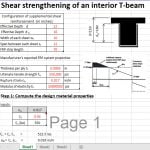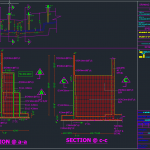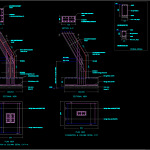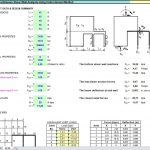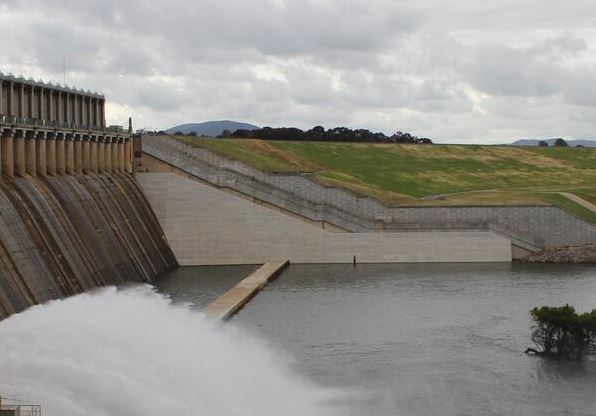
What is a Buttress Dam ? Types, advantages and disadvantages
20 November 2021Table of Contents
What is a Buttress Dam ? Types, advantages and disadvantages
A buttress dam is also called as a hollow dam. It is a dam with a solid, water-tight upstream side that is supported at intervals on the downstream side by a series of supports. A reinforced concrete slab or a series of arches or thickened buttress heads may form the sloping membrane for retaining the upstream water. At the upstream end, a cut-off is provided to prevent or reduce the seepage of water.
What is Buttress?
A buttress is a thin wall of triangular profile shape. It has a characteristic of sloping upstream face. It is usually spaced at equal interval along the length of the dam and is supported either on a continuous mat foundation or on a separate spread footing. Each arch of the dam is supported by the buttresses. Multiple arch buttress dams are more durable and flexible than other buttress dams, such as a deck slab buttress dam.
Types of Buttress Dams
Deck slab Buttress Dam
The deck slab buttress dams are also known as Ambursen type buttress dams in honour of Nils F Ambursen who in 1903 built the first flat slab type of buttress dam. In this type of buttress dam, the sloping membrane or deck consists of a reinforced concrete slab supported by a series of buttresses. The inclination of the deck slab is kept between 40 to 55 degrees with the horizontal. In order to provide a wide base for the slab supported by the buttress the upstream end of the buttress where it joins the slab is usually made wide by providing haunch or corbel.
The deck slab buttress dam can be categorized into three types:
- Fixed deck slab
- Free deck slab
- Cantilever slab
Each is having its own advantages and drawbacks. Advantage of the deck slab dam is that the deck slabs work together as a multiple arch dam for proper support. However, it is not like multiple arch dams, if one of the slabs gets damaged the damage will not affect the other slabs.
Buttress dams can be referred to as a gravity dam. The dam in which the concrete and material of the dam are designed to hold all the horizontal force and pressure of the water. Water pressure is distributed to the slabs of the Buttresses. Distributing the forces will reduce the load on the wall, allowing the dam to last longer.
Multiple arch Buttress dam
In this type of buttress dam, the sloping membrane or deck consists of a series of reinforced-concrete arches supported by a number of buttresses. The upstream face of the dam is usually inclined at 45. The arches are cast monolithically with the buttresses. Multiple arch buttress dams are more durable and flexible than other buttress dams, such as a deck slab buttress dam. The dam can be constructed as a singular stiffened wall or a double hollow one. The biggest disadvantage of the dam is that buttresses depend on each other. It means that if one buttress develops problems the whole dam will lose its efficiency. This dam is suitable for larger heights preferably above 50 meters.
Multiple Dome Buttress Dam
In this type of Buttress dam, the sloping membrane or deck consists of a series of reinforced-concrete domes supported by a number of buttresses. Most of the characteristics are the same as a multiple arch dam, however, instead of having arches it has domes. Using multiple domes help to reduce the number of buttresses required to make the dam stable. The main benefit is that the domes can be spaced farther apart than arches can be placed. It helps in reducing cost and saving material during designing of the dam.
Massive head Buttress dam
The main feature of this type of dam is, there is no separate water-retaining member is provided and the water-retaining member is formed only by enlarging the upstream end side of the buttress. Thus the dam is made with a series of buttresses and massive heads placed side by side. They are constructed with concrete mass and little reinforcement. This makes its construction relatively easy compared to other types of buttress dams. The weight of the concrete makes massive head buttress dams very heavy, and very resistant to sliding.
This type of buttress dam does not have a slab or arch at the upstream face like other buttress dams. Instead of having slab at the upstream face, the massive head buttress dams have buttress heads that are extended and connected with other buttress heads. The larger buttress heads can be made in different shapes i.e. round and diamond. These extensions of the buttresses are made stronger by using copper strips in the construction. The massive head buttress dam is resistant to sliding because of its weight.
Columnar Buttress dam
In this type of columnar buttress dam, the columns support the deck slab of the dam. The columns are inclined to the better support of the flat deck of the dam. The flat deck slabs are used to replace the buttresses. It is an altered deck slab buttress dam. It needs a very durable base. It requires skilled personnel to create buttresses. This is why it is not popular as much at the other types of buttress dams.
Advantages of Buttress dams
- The Buttress dam can be constructed on a relatively weak foundation.
- Buttress dams can be designed to fit in moderate amounts of foundation movement without serious damages, thus it can be built in the soil with differential settlements.
- The amount of concrete required for a buttress dam is about 1/3 to ½ of the concrete required for a gravity dam of the same height
- There is no problem with uplift or foundation drainage.
- The uplift pressure acting on a buttress dam is considerably less which leads to economy in the concrete and overall stability of the dam.
- The powerhouse, switchyard, etc., can be located between the buttresses thus saving some cost of construction.
Disadvantages of a Buttress dam
- Buttress dam requires more for work than solid concrete dams.
- As the thickness of the upstream concrete surface is less, it is more liable to get deteriorated.
- It requires constant maintenance and supervision.
- Life of the dam is less as compared to other dams.
- Skilled labour requirements and the shuttering to concrete ratio are greater for buttress dam than for a gravity dam. This may lead to a higher unit rate of concrete.
- The number of water seals to be provided and maintained for a buttress dam is usually more than for other dams.

